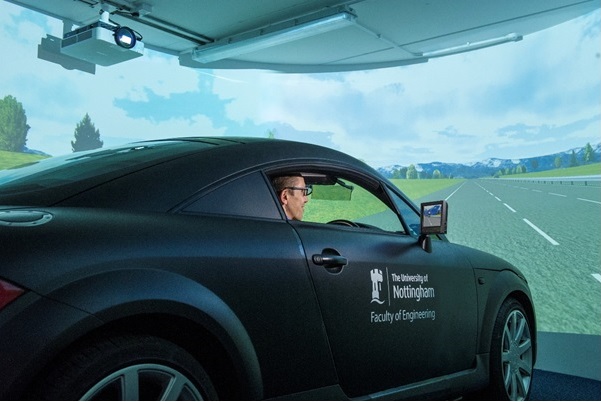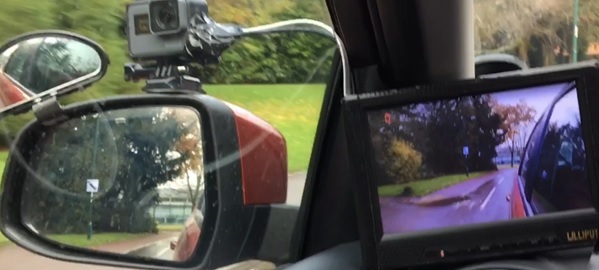
February 12, 2020, by Digital Research
Driving simulators: four years as an automotive Human Factors researcher
My name is Dr Sanna Pampel, new Digital Research Specialist (as of January 2020) and the main contact point in that role for the Faculty of Engineering and the Faculty of Arts.
My face may be familiar to Engineering colleagues as I was, from November 2015 to December 2019, a Research Fellow for Automotive Human Factors. In that role, I tested user interfaces for cars, including digital mirrors, augmented-reality “follow-me-car” virtual reality navigation systems in head-up-displays, as well as touch pads and user interfaces for automated cars.
Many of these systems are still under development and years from market release. However, we needed a way to evaluate their efficacy and answer important questions such as: do drivers ever look away from the road longer than two seconds? Does the loud sound alerting drivers to the deactivation of automation systems cause stress? Can symbols projected onto the road help older or sight-impaired drivers? Do people prefer this technology over more traditional systems? Driving simulators are the perfect, safe environment for probing such questions.

Figure 1 – The Human Factors Driving Simulator at the University of Nottingham
To ensure that results from driving simulator research are transferable to the real world, I also ventured out onto the roads. Following months of negotiations with the Health and Safety office, a very thorough risk assessment and specialist driving instructor training, I was able to have participants drive on the motorway and press buttons on a touch screen. This has been one of the most enjoyable studies of my research career, and for which I won an honourable mention award at the Automotive User Interfaces Conference 2019 (in Utrecht; see publications below).
Finally, just before Christmas, you might have noticed curious signs along the roads of the University Park Campus, showing the letter ‘i’ tilted in different directions. We used these to compare digital mirrors with traditional wing mirrors, looking particularly at how well people perform when trying to establish the direction of the letter. The answer: participants responded more quickly when they used the digital mirror.

Figure 2 – Seeing signs on lampposts through a traditional and a digital mirror (credit: Anastasia Schkreba)
If anyone would like to learn more about these experiments or about my new role as a Digital Research Specialist, please get in touch. You can find my contact details and those of my digital research colleagues here.
Publications
PAMPEL, S. M., LAMB, K., BURNETT, G., SKRYPCHUK, L., HARE, C. and MOUZAKITIS, A., 2019. An investigation of the effects of driver age when using novel navigation systems in a head-up display: Presence: Teleoperators and Virtual Environments Presence: Teleoperators and Virtual Environments. 27(1), 32-45
PAMPEL, S.M., BURNETT, GARY, HARE, CHRISMINDER, SINGH, HARPREET, SHABANI, ARBER, SKRYPCHUK, LEE and MOUZAKITIS, ALEX, 2019. Fitts Goes Autobahn: Assessing the Visual Demand of Finger-Touch Pointing Tasks in an On-Road Study In: Proceedings of the 11th International Conference on Automotive User Interfaces and Interactive Vehicular Applications. 254-261
PAMPEL, S., LARGE, D.R., BURNETT, G., MATTHIAS, R., THOMPSON, S. and SKRYPCHUK, L., 2018. Getting the driver back into the loop: The quality of manual vehicle control following long and short non-critical transfer-of-control requests Theoretical Issues in Ergonomics Science (TIES).
Sorry, comments are closed!
